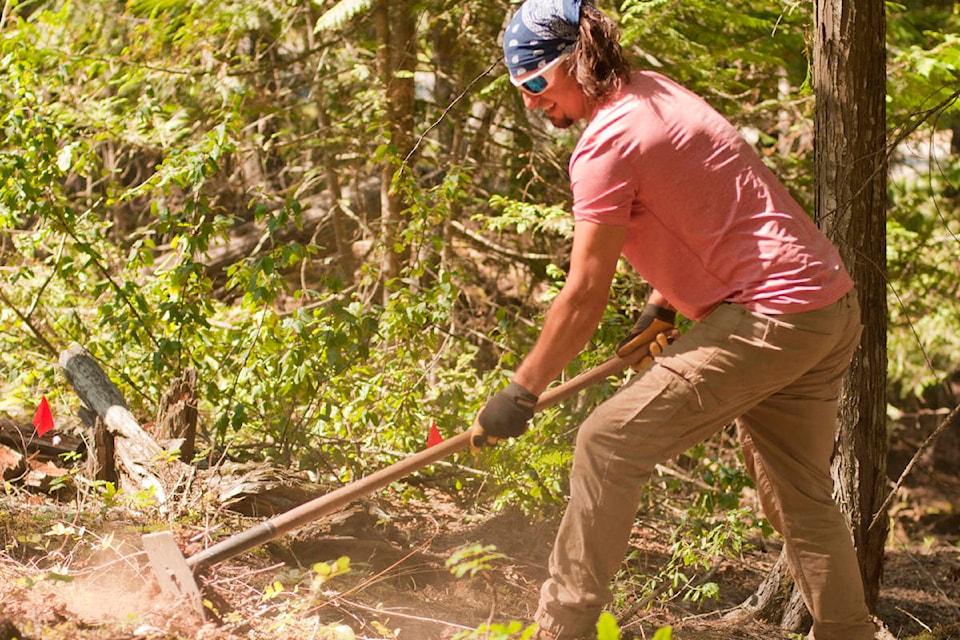It’s a hot August day and Farley Cursons and Taz Archambault are hard at work. They’re partly shaded by trees, and dust flies as they attack the forest floor with picks and shovels, developing a new trail in a “top-secret” location near Riondel.
The Riondel Heritage Trail will be part of the network maintained by the East Shore Trail and Bike Association (ESTBA), which has a goal — one of many — to accommodate an increased interest in local and visiting mountain bikers and hikers.
“We think of these trails as a recreation facility,” said Cursons, ESTBA projects manager. “When you think of the cost to maintain a park or pool, then recreation trails are an affordable comparison.”
ESTBA started in 2014, with a mission to create a co-ordinated and inclusive process to guide the preservation of, use and environmentally sustainable growth of non-motorized trail use on the East Shore. Funded mainly by Columbia Basin Trust and the Regional District of Central Kootenay, it was an immediate success.
“We hit the ground running,” said Cursons. “We started just making a trail map but found ourselves creating a provincial work program while getting trails authorized.”
The organization now maintains about 35 kilometres of trails, which includes about 25 kilometres on Crawford and Pilot peninsulas, it also promotes trails high in the mountains, such as the access to Mount Loki and Plaid Lake. ESTBA also looks after the Crawford Bay-Gray Creek portion of the Great Trail (formerly the Trans Canada Trail), which attracts a lot of tourists, and is one of the first projects Cursons and Archambault tackled for ESTBA.
“It prepared us for building trails pretty much anywhere,” said Cursons, driving a pick into the forest floor. “Every time we build trails, we learn something new, and apply the techniques we’ve used.”
The methods they use to cut new trails differs from some of the more traditional methods, which typically meant trails would be narrow, running straight through the path of least resistance, with overhanging growth requiring regular trimming back. The process used by ESTBA sees trails dug about four or five feet wide and down to the mineral soil (to aid with water shedding), with edges firmed up by rocks uncovered by the digging. And most are kept to a grade of 10 per cent or less, which reduces skidding by cyclists and runoff water from channeling.
It makes for more intense initial work, but reduces the need for future maintenance, while ensuring the trails can accommodate hikers of all types — and there are quite a few.
“For some, they check their pulse and time,” said Archambault. “Some go from point A to point B. For others, it’s about nature — they look at the plants and trees. For others, it’s social — when they have visitors, it’s, ’Let’s go walk on the trails.’ ”
For Cursons and Archambault, who also do interface forest fuel reduction work together, the trail building they are doing is a natural fit.
Archambault came to B.C. from Manitoba in the early 1990s, studying at North Vancouver’s Capilano College to become a professional landscaper, which led him to the East Shore, where he worked for the Tipi Camp and became the trail crew leader for Guiding Hands Recreation Society.
Cursons is a self-described “back to the land kid” from the 1970s, whose parents moved to the Arrow Lakes from White Rock. He left for a bit, but returned to Nelson in the mid-1990s, making the move to the East Shore 14 years ago. He’s involved with several organizations, including Guiding Hands, Starbelly Jam and Building East Shore Tourism.
With a daughter in Grade 6, he’s hoping that the increased trail infrastructure will help to attract more families to the area, bolstering the dwindling student population at Crawford Bay Elementary-Secondary School.
“Everything we do is to try to attract families here,” he said.
Family was the focus of the Riondel Age Friendly Community Society, which initiated the Riondel Heritage Trail and whose members had many fundraisers and wrote the grant applications that made the work possible.
“A group of seniors wanted to better their community, and take their grandkids for walks,” said Cursons.
ESTBA’s work won’t stop with the Riondel trail. Two more are in the works, and a proposal has been submitted for the future Crawford Bay Regional Park. Cursons and Archambault are also scouting a route for easy access to the peak of Crawford Peninsula.
And while the society continues its goal of improving the East Shore outdoors community in the short-term, its trail builders appreciate the challenge and privilege of creating a legacy for the future.
“These trails may be here long after we’re gone — especially some of the bigger rock work,” said Archambault, gesturing to the boulder-edged infant trail.
“People are going to enjoy our work for generations,” said Cursons.
To lean more about the East Shore Trail and Bike Association or to download a trail map, visit estba.ca.
